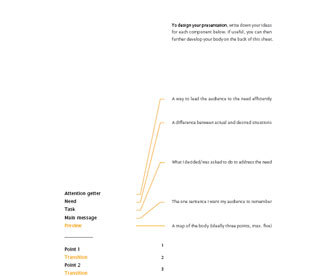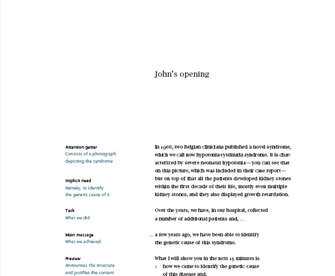« Prev Next »

Oral Presentation Structure
Like scientific papers, oral presentations at a conference or internal seminar are for sharing your research work with other scientists. They, too, must convince the audience that the research presented is important, valid, and relevant to them. To this end, oral presentations — like papers — must emphasize both the motivation for the work and the outcome of it, and they must present just enough evidence to establish the validity of this outcome. Also like papers, they must aim to inform, not impress.
In contrast, presentations differ from papers in at least three ways: They are more localized in space and time, they impose a sequence and rhythm to the audience, and they normally include some level of interaction. These three differences affect the selection of a presentation's content.
Unless they are recorded or broadcast, presentations have a more clearly defined audience than papers: They address "the people in the room," here and now. The audience might still be diverse, but less so than for papers. Papers can be forwarded in unpredictable ways and may be read many years from now, so they should be lasting and largely self-contained. In contrast, presentations can have more specific purposes. For example, a presentation at a conference normally aims to present recent advances, whereas a presentation at a Ph.D. symposium aims to inform other Ph.D. students (in other fields) of one student's line of research.
Finally, presentations normally include interaction in the form of questions and answers. This is a great opportunity to provide whatever additional information the audience desires. For fear of omitting something important, most speakers try to say too much in their presentations. A better approach is to be selective in the presentation itself and to allow enough time for questions and answers and, of course, to prepare well by anticipating the questions the audience might have.
As a consequence, and even more strongly than papers, presentations can usefully break the chronology typically used for reporting research. Instead of presenting everything that was done in the order in which it was done, a presentation should focus on getting a main message across in theorem-proof fashion — that is, by stating this message early and then presenting evidence to support it. Identifying this main message early in the preparation process is the key to being selective in your presentation. For example, when reporting on materials and methods, include only those details you think will help convince the audience of your main message — usually little, and sometimes nothing at all.
The opening
- The context as such is best replaced by an attention getter, which is a way to both get everyone's attention fast and link the topic with what the audience already knows (this link provides a more audience-specific form of context).
- The object of the document is here best called the preview because it outlines the body of the presentation. Still, the aim of this element is unchanged — namely, preparing the audience for the structure of the body.
- The opening of a presentation can best state the presentation's main message, just before the preview. The main message is the one sentence you want your audience to remember, if they remember only one. It is your main conclusion, perhaps stated in slightly less technical detail than at the end of your presentation.
In other words, include the following five items in your opening: attention getter, need, task, main message, and preview.
The body
Even if you think of your presentation's body as a tree, you will still deliver the body as a sequence in time — unavoidably, one of your main points will come first, one will come second, and so on. Organize your main points and subpoints into a logical sequence, and reveal this sequence and its logic to your audience with transitions between points and between subpoints. As a rule, place your strongest arguments first and last, and place any weaker arguments between these stronger ones.
The closing
After supporting your main message with evidence in the body, wrap up your oral presentation in three steps: a review, a conclusion, and a close. First, review the main points in your body to help the audience remember them and to prepare the audience for your conclusion. Next, conclude by restating your main message (in more detail now that the audience has heard the body) and complementing it with any other interpretations of your findings. Finally, close the presentation by indicating elegantly and unambiguously to your audience that these are your last words.
Starting and ending forcefully
The first few sentences and last few sentences of an oral presentation are particularly important because they shape the first and last impressions you make on your audience. They are also particularly difficult since they correspond to moments of transition (starting and ending) during which your stage fright is likely to peak. Thus, they deserve special attention.
At the beginning of any presentation, you must get the attention of the audience — and you must do so quickly. Whether audience members are still happily chatting or already silent (for example, because a chairperson introduced you), they are not yet engaged. As with a paper, you can spark their interest for your research by stating the need for your work, but you must first secure their full attention with an attention getter.
An effective attention getter can take many forms: It can be a question, a statement, an anecdote (humorous or not), an analogy, a quotation, an object, a picture projected on the screen, and so on. Whatever its form, it has three qualities:
- An effective attention getter is short. It is not a goal in itself, but rather a means to focus the audience's undivided attention on the need (which is the true motivation for the work presented).
- An effective attention getter is audience-oriented. It bridges the gap between something the audience is familiar with or cares about and the topic of the talk. As a counterexample, beginning a presentation by saying "My name is Irma Kodowski and I would like to talk to you today about . . . " is not effective, because it is strongly self-centered. Wait until the task to talk about yourself.
- An effective attention getter is relevant and appropriate, as opposed to out-of-place or overdramatic. As a counterexample, starting your presentation with a joke unrelated to the topic will likely strike the audience as irrelevant. Starting with a humorous anecdote directly related to the topic is at least relevant; whether it is also appropriate depends on the situation. Usually, less specialized audiences require more creative attention getters because they are more distant from the topic. For audiences of specialists, a simple link with a familiar context ("As most of you know, . . . ") or with the previous speaker ("As Dr. Chandrasekhar just pointed out, . . . ") may suffice.
At the end of a presentation, you must indicate elegantly yet unambiguously to the audience that you have said your last words, thus giving them the signal to applaud. Although there are many ways to do so, one that works well is to make the link back to your attention getter: By referring back to your initial question, analogy, picture, etc., you indicate that you have completed the loop. In contrast, beware of conventional yet extrinsic closes. "So, that's all I had for you today," suggests that you ran out of things to say; you should prepare a deliberate close instead. "Thank you for your attention," is weak; make your audience thank you for delivering a great presentation instead. "I will be happy to answer any questions you have," is premature; you should save this prompt for after the applause.
Your attention getter and close should be your very first words and very last words, respectively. Resist the temptation to preface your attention getter with filler words ("well, um, so, yes") or unnecessary courtesies ("Good morning everyone. Let me first thank the organizers for . . . "). To make sure you start and end your presentation sharply, you might want to learn your first few and last few sentences by heart.
Revealing your presentation's structure
To be able to give their full attention to content, audience members need structure — in other words, they need a map of some sort (a table of contents, an object of the document, a preview), and they need to know at any time where they are on that map. A written document includes many visual clues to its structure: section headings, blank lines or indentations indicating paragraphs, and so on. In contrast, an oral presentation has few visual clues. Therefore, even when it is well structured, attendees may easily get lost because they do not see this structure. As a speaker, make sure you reveal your presentation's structure to the audience, with a preview, transitions, and a review.
The preview provides the audience with a map. As in a paper, it usefully comes at the end of the opening (not too early, that is) and outlines the body, not the entire presentation. In other words, it needs to include neither the introduction (which has already been delivered) nor the conclusion (which is obvious). In a presentation with slides, it can usefully show the structure of the body on screen. A slide alone is not enough, however: You must also verbally explain the logic of the body. In addition, the preview should be limited to the main points of the presentation; subpoints can be previewed, if needed, at the beginning of each main point.
Transitions are crucial elements for revealing a presentation's structure, yet they are often underestimated. As a speaker, you obviously know when you are moving from one main point of a presentation to another — but for attendees, these shifts are never obvious. Often, attendees are so involved with a presentation's content that they have no mental attention left to guess at its structure. Tell them where you are in the course of a presentation, while linking the points. One way to do so is to wrap up one point then announce the next by creating a need for it: "So, this is the microstructure we observe consistently in the absence of annealing. But how does it change if we anneal the sample at 450°C for an hour or more? That's my next point. Here is . . . "
Similarly, a review of the body plays an important double role. First, while a good body helps attendees understand the evidence, a review helps them remember it. Second, by recapitulating all the evidence, the review effectively prepares attendees for the conclusion. Accordingly, make time for a review: Resist the temptation to try to say too much, so that you are forced to rush — and to sacrifice the review — at the end.
Ideally, your preview, transitions, and review are well integrated into the presentation. As a counterexample, a preview that says, "First, I am going to talk about . . . , then I will say a few words about . . . and finally . . . " is self-centered and mechanical: It does not tell a story. Instead, include your audience (perhaps with a collective we) and show the logic of your structure in view of your main message.

Within this Subject (22)

























